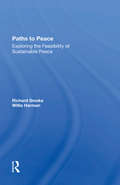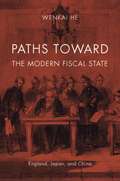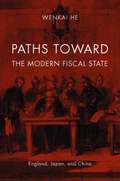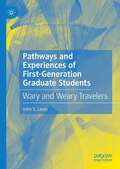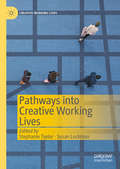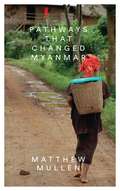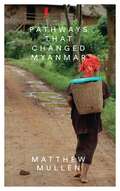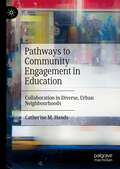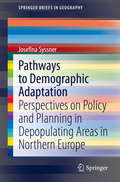- Table View
- List View
Paths to Democracy: Revolution and Totalitarianism
by Rosemary H. O'KaneHow and why countries become democracies remain intriguing questions. This innovative volume provides a theoretically informed comparative investigation of the links between revolutions, totalitarianism and democracy. It will appeal to those interested in the relationship between history and democracy and the implications for the understanding of democracy today.
Paths To Homelessness: Extreme Poverty And The Urban Housing Crisis
by Doug A Timmer D. Stanley Eitzen Kathryn D. Talley D Stanley EitzenThe major theme in this book is that people are homeless because of structural arrangements and trends that result in extreme impoverishment and a shortage of affordable housing in U.S. cities. It explains the economic and historical causes of homelessness with accounts of individuals and families.
Paths To Homelessness: Extreme Poverty And The Urban Housing Crisis
by Doug A Timmer D. Stanley Eitzen Kathryn D. Talley D Stanley EitzenThe major theme in this book is that people are homeless because of structural arrangements and trends that result in extreme impoverishment and a shortage of affordable housing in U.S. cities. It explains the economic and historical causes of homelessness with accounts of individuals and families.
Paths to Peace: The UN Security Council and Its Presidency
by Davidson NicolPaths to Peace: The UN Security Council and its Presidency documents the works, experiences, and roles of the former presidents of the UN Security Council, which is one of the principal organs of the UN. This book first characterizes the council, including the evolution of its practice and the scope of consensus. This text then describes the scope of power of a president of the council, which is followed by papers presenting a reflection of a former president on his presidency. An intimate and internal view of the presidency by a former Director of the Security Council, Division of the UN Secretariat is then presented. Other papers tackle various experiences of former presidents, particularly in dealing with several nations. This text will be invaluable to those working in the United Nations and aim to learn from the experts, as well as to those academicians and professionals interested in public administration.
Paths To Peace: Exploring The Feasibility Of Sustainable Peace
by Richard Smoke Willis W HarmanA primer on thinking about peace in a nuclear age, this book describes the kinds of peace efforts that have been tried–and those that might be tried–from the highest echelons of government policymaking to the grassroots level of individual endeavour. Its primary goal is to enable the reader to understand ways of eliminating the threat of nuclear war and to be empowered to take action. The book describes and compares nine basic methods people have used to achieve peace, ranging from such conventional approaches as the theories of deterrence and balance of power to more unconventional strategies such as nonviolent resistance. Essentially all significant ideas for achieving and maintaining international peace fall into one of these nine categories or combine features from several. Many have been tried, but all clearly have been found wanting. Yet the authors' tone is one of optimism as they explore some of the major changes of the past quarter century. They contend that these changes alter the balance of advantages and disadvantages among the various paths to peace, so that what seemed partially workable in the past may not be appropriate to the present and what seemed totally impractical in the past might have a chance of working today. The book concludes with a scenario that may make a stable peace possible in the foreseeable future.
Paths To Peace: Exploring The Feasibility Of Sustainable Peace
by Richard Smoke Willis W HarmanA primer on thinking about peace in a nuclear age, this book describes the kinds of peace efforts that have been tried–and those that might be tried–from the highest echelons of government policymaking to the grassroots level of individual endeavour. Its primary goal is to enable the reader to understand ways of eliminating the threat of nuclear war and to be empowered to take action. The book describes and compares nine basic methods people have used to achieve peace, ranging from such conventional approaches as the theories of deterrence and balance of power to more unconventional strategies such as nonviolent resistance. Essentially all significant ideas for achieving and maintaining international peace fall into one of these nine categories or combine features from several. Many have been tried, but all clearly have been found wanting. Yet the authors' tone is one of optimism as they explore some of the major changes of the past quarter century. They contend that these changes alter the balance of advantages and disadvantages among the various paths to peace, so that what seemed partially workable in the past may not be appropriate to the present and what seemed totally impractical in the past might have a chance of working today. The book concludes with a scenario that may make a stable peace possible in the foreseeable future.
Paths to Peace: Domestic Coalition Shifts, War Termination and the Korean War
by Elizabeth A. StanleyPaths to Peace begins by developing a theory about the domestic obstacles to making peace and the role played by shifts in states' governing coalitions in overcoming these obstacles. In particular, it explains how the longer the war, the harder it is to end, because domestic obstacles to peace become institutionalized over time. Next, it tests this theory with a mixed methods approach—through historical case studies and quantitative statistical analysis. Finally, it applies the theory to an in-depth analysis of the ending of the Korean War. By analyzing the domestic politics of the war's major combatants—the Soviet Union, the United States, China, and North and South Korea—it explains why the final armistice terms accepted in July 1953 were little different from those proposed at the start of negotiations in July 1951, some 294,000 additional battle-deaths later.
Paths toward the Modern Fiscal State: England, Japan, And China
by Wenkai HeWenkai He shows why England and Japan, facing crises in public finance, developed the tools and institutions of a modern fiscal state, while China, facing similar circumstances, did not. He’s explanation for China’s failure at a critical moment illuminates one of the most important but least understood transformations of the modern world.
Paths toward the Modern Fiscal State: England, Japan, And China
by Wenkai HeWenkai He shows why England and Japan, facing crises in public finance, developed the tools and institutions of a modern fiscal state, while China, facing similar circumstances, did not. He’s explanation for China’s failure at a critical moment illuminates one of the most important but least understood transformations of the modern world.
Pathways and Consequences of Legal Irregularity: Senegalese Migrants in France, Italy and Spain (IMISCOE Research Series)
by Erik R. VickstromThis open access book provides a unique study of the complexities and consequences of irregular legal status of Senegalese migrants in Europe. It employs sophisticated quantitative methods to analyze unique life-history data to produce policy-relevant conclusions. Using the MAFE dataset as empirical evidence, the book focuses on the legal paths of Senegalese migrants in three different European countries. It shows how multiple contexts of reception produce pathways into irregular legal status and how the resulting complex configurations of irregular status shape migrants’ economic integration into their host societies as well as their ongoing participation in the development of their sending societies. The book thereby increases our understanding of the functioning of African migration systems and the corresponding inclusion patterns in Europe. As such this book will be of interest to scholars working in migration studies, policy makers, and legal professionals.
Pathways and Experiences of First-Generation Graduate Students: Wary and Weary Travelers
by John S. LevinThis book focuses on first-generation graduate students in the US and the graduate or post-baccalaureate programs that house and educate these students. The several voices in this book, including first-generation graduate students, address the phenomena of graduate students’ experiences and related university practices, with the practices connected to traditional academic and Western values and to academic and neoliberal institutional logics. First-generation graduate students’ narratives, or testimonies, serve as the foundation of the analysis of students’ pathways to graduate school and their experiences within graduate school. The conditions for first-generation graduate students in their programs require remedies that will facilitate student well-being, peer community attachment, and persistence, and will educate and train students for achievement in graduate school and for employment after graduate school.
Pathways for Irregular Forces in Southeast Asia: Mitigating Violence with Non-State Armed Groups (Routledge Contemporary Southeast Asia Series)
by Atsushi Yasutomi, Rosalie Arcala Hall and Saya KibaAn exploration of the roles that pro- and anti-government militias, private armed groups, vigilantes, and gangs play in local communities in the new democracies of Southeast Asia. Scholars have typically characterized irregular forces as spoilers and infiltrators in post-conflict peacebuilding processes. The contributors to this book challenge this conventional understanding of irregular forces in Southeast Asia, demonstrating that they often attract solid support from civilians and can be major contributors to the building of local security — a process by which local residents, in the absence of an effective police force, develop, partner or are at least included in the management of community crimes and other violence. They analyze irregular forces’ dealings with political actors at the community level, explaining why and how forces are incorporated in and collaborate with legitimate institutions without using violence against them. Offering a new approach to dealing with irregular forces in Southeast Asia, contributors explore new theoretical frameworks that are better suited for evaluating irregular forces’ relationship to different security providers and the political environments in the region. Specifically, they examine case studies from Indonesia, Timor-Leste, the Philippines, and Thailand. A valuable resource for researchers, students and practitioners in the areas of conflict resolution, peacebuilding, and security governance, especially those with a focus on Southeast Asia. This book will also be of great interest to scholars of the sociology and anthropology of the region.
Pathways for Irregular Forces in Southeast Asia: Mitigating Violence with Non-State Armed Groups (Routledge Contemporary Southeast Asia Series)
by Atsushi Yasutomi Rosalie Arcala Hall Saya KibaAn exploration of the roles that pro- and anti-government militias, private armed groups, vigilantes, and gangs play in local communities in the new democracies of Southeast Asia. Scholars have typically characterized irregular forces as spoilers and infiltrators in post-conflict peacebuilding processes. The contributors to this book challenge this conventional understanding of irregular forces in Southeast Asia, demonstrating that they often attract solid support from civilians and can be major contributors to the building of local security — a process by which local residents, in the absence of an effective police force, develop, partner or are at least included in the management of community crimes and other violence. They analyze irregular forces’ dealings with political actors at the community level, explaining why and how forces are incorporated in and collaborate with legitimate institutions without using violence against them. Offering a new approach to dealing with irregular forces in Southeast Asia, contributors explore new theoretical frameworks that are better suited for evaluating irregular forces’ relationship to different security providers and the political environments in the region. Specifically, they examine case studies from Indonesia, Timor-Leste, the Philippines, and Thailand. A valuable resource for researchers, students and practitioners in the areas of conflict resolution, peacebuilding, and security governance, especially those with a focus on Southeast Asia. This book will also be of great interest to scholars of the sociology and anthropology of the region.
Pathways from Preferential Trade: The Politics of Trade Adjustment in Africa, the Caribbean and Pacific (International Political Economy Series)
by T. HeronTony Heron examines recent global policy responses to the erosion of non-reciprocal tariff and quota preferences caused trade liberalizing by focusing on a sample of small, middle income countries which have historically enjoyed favourable access to OECD markets.
Pathways into Creative Working Lives (Creative Working Lives)
by Stephanie Taylor Susan LuckmanThis book presents research on pathways into creative work. The promise of ‘doing what you love’ continues to attract new entrants to the cultural and creative industries. Is that promise betrayed by the realities of pathways into creative work, or does a creative identification offer new personal and professional possibilities in the precarious contexts of contemporary work and employment? Two decades into the 21st century, aspiring creative workers undertake training and higher education courses in increasing numbers. Some attempt to convert personal enthusiasms and amateur activities into income-earning careers. To manage the uncertainties of self-employment, workers may utilise skills developed in other occupations, even developing timely new forms of collective organisation. The collection explores the experience of creative career entrants in numerous national contexts, including Australia, Belgium, China, Ireland, Italy, Finland, the Netherlands, Russia, the US and the UK. Chapters investigate the transitions of new workers and the obstacles they encounter on creative pathways.Chapters 1, 12 and 15 are available open access under a Creative Commons Attribution 4.0 International License via link.springer.com.
Pathways of Autocratization: The Tumultuous Journey of Bangladeshi Politics (Routledge Advances in South Asian Studies #44)
by Ali RiazPathways of Autocratization addresses contemporary global politics’ one of the most important questions: how does a country regress from a democracy to an autocracy? This book offers a novel framework for understanding the processes that erode democracy and lead to autocracy and explains a specific instance of democratic backsliding in Bangladesh: the world’s eighth most populous country. With probing analysis of events and trends of Bangladeshi politics, especially since 2009, the book contextualizes the country’s autocratization process within global trends and compares it with others which have trod a similar path in recent decades, including Bolivia, Cambodia, Hungary, Poland, the Philippines and Turkey. The book discusses the implications of institutional changes, the role of pliant media, the contribution of ideology, and the conduct of international actors in the autocratization process while also mapping future trajectories for the country. Succinct, incisive, and thought provoking, this book is rich in its theoretical robustness and empirical details. This is a must-read for anyone interested in understanding the dynamics of democratic backsliding and prospects for reversing this trend.
Pathways of Autocratization: The Tumultuous Journey of Bangladeshi Politics (Routledge Advances in South Asian Studies #44)
by Ali RiazPathways of Autocratization addresses contemporary global politics’ one of the most important questions: how does a country regress from a democracy to an autocracy? This book offers a novel framework for understanding the processes that erode democracy and lead to autocracy and explains a specific instance of democratic backsliding in Bangladesh: the world’s eighth most populous country. With probing analysis of events and trends of Bangladeshi politics, especially since 2009, the book contextualizes the country’s autocratization process within global trends and compares it with others which have trod a similar path in recent decades, including Bolivia, Cambodia, Hungary, Poland, the Philippines and Turkey. The book discusses the implications of institutional changes, the role of pliant media, the contribution of ideology, and the conduct of international actors in the autocratization process while also mapping future trajectories for the country. Succinct, incisive, and thought provoking, this book is rich in its theoretical robustness and empirical details. This is a must-read for anyone interested in understanding the dynamics of democratic backsliding and prospects for reversing this trend.
Pathways that Changed Myanmar
by Matthew MullenIn the midst of the political upheavals that engulfed Myanmar from 2010 to 2011, international attention was fixed upon the military regime and its dissident opponents. But away from the cameras, a very different set of struggles were unfolding across the country. These struggles were manifested not as violent clashes, but as everyday interactions involving taxi drivers, community organizers, farmers, heads of domestic NGOs, and many more.A product of five years' research, during which the author conducted over five hundred ethnographic interviews across the country, Pathways that Changed Myanmar provides a voice for those ordinary Burmese whose trials and aspirations went unheard and unnoticed during this pivotal moment in the nation's history.
Pathways that Changed Myanmar
by Matthew MullenIn the midst of the political upheavals that engulfed Myanmar from 2010 to 2011, international attention was fixed upon the military regime and its dissident opponents. But away from the cameras, a very different set of struggles were unfolding across the country. These struggles were manifested not as violent clashes, but as everyday interactions involving taxi drivers, community organizers, farmers, heads of domestic NGOs, and many more.A product of five years' research, during which the author conducted over five hundred ethnographic interviews across the country, Pathways that Changed Myanmar provides a voice for those ordinary Burmese whose trials and aspirations went unheard and unnoticed during this pivotal moment in the nation's history.
Pathways to Community Engagement in Education: Collaboration in Diverse, Urban Neighbourhoods
by Catherine M. HandsThis book takes a comprehensive look at community engagement strategies in education to demonstrate the diverse nature of school-community relations and their value to promote their effective development. The author brings twenty years of experience in various educational settings in Ontario and California to examining community involvement policies and their interpretation, as well as school-community collaboration in practice. Chapters include recent research on school-community collaboration from the perspective of teachers, school district leaders, administrators, and support staff within two school districts in a low-income and culturally diverse urban community. The book also includes perspectives from community members involved in organizations across the city with a mandate to work with youth. In a time where students’ academic, social, and emotional support needs are on the rise, this book offers a valuable resource for strengthening school-community relations and demonstrating the power of collaboration.
Pathways to Democracy: The Political Economy of Democratic Transitions
by James F. Hollifield Calvin JillsonFirst Published in 2000. Routledge is an imprint of Taylor & Francis, an informa company.
Pathways to Democracy: The Political Economy of Democratic Transitions
by James Frank Hollifield Calvin C. JillsonFirst Published in 2000. Routledge is an imprint of Taylor & Francis, an informa company.
Pathways to Demographic Adaptation: Perspectives on Policy and Planning in Depopulating Areas in Northern Europe (SpringerBriefs in Geography)
by Josefina SyssnerThis book builds on case studies in depopulating and shrinking areas in Northern Europe. While most contemporary literature on shrinkage focuses on these issues from a planning standpoint, this book uniquely applies a policy perspective when approaching the material. The book assesses the potential of demographic adaptation policies to manage depopulation, that is, policy programs aiming at managing depopulation through adaptation, rather than through growth policies intended to foster population growth. In 6 chapters, the book acts as an up-to-date resource on demographic adaptation for master and Ph.D. students, researchers, and practitioners working in local and regional development, governance, and planning. Chapter 1 gives an overview of recent demographic trends in Northern Europe and introduces the theoretical differences between growth policy and adaptation policy. Chapter 2 accounts for the policy concept and introduces a framework for how local adaptation policies could be systematically analysed. Chapter 3 suggests that the Nordic welfare states exhibit two characteristics that prove to be relevant when discussing the consequences and policy implications of demographic decline, i.e. an extremely sparse population structure and an ambitious welfare assignment that in many respects has been devolved to the local level of government. Chapter 4 suggests that whether shrinkage constitutes a problem or not depends upon the interpretations of those in power, but also upon political, economic and geographic conditions Chapter 5 seeks to understand why local level policymakers avoid developing strategies for how to handle long-term population decline. Chapter 6 summarizes the points of the previous chapters, and concludes that local governments in shrinking areas ought to develop local adaptation policies. These policies, however, also need to be subjected to critical analysis, and the chapter introduces a model for how local adaptation policy priorities could be assessed in a more structured manner.
Pathways to Development: From Politics to Power
by Prof Kunal Sen Prof Samuel HickeyThis is an open access title available under the terms of a CC BY-BC-ND 4.0 International License. It is free to read at Oxford Scholarship Online and offered as a free PDF download from OUP and selected open access locations. The puzzle of why some countries are wealthier and more developed than others continues to confound students and practitioners of development alike. Whereas earlier grand explanations focused on issues of 'geography' or 'institutions', the second decade of the 21st century finally saw 'politics' arrive centre-stage within international development. This catalyzed a search to answer the key question: under what conditions do governments become committed to and capable of delivering development? How can these processes be conceptualized and researched? And what (if anything) can be done to 'get the politics right' for development? Pathways to Development draws on a major comparative research effort to present new answers to the question of how politics shapes development. It develops and applies a 'power domains' framework across multiple countries in the global South to uncover the political drivers of development across a wide range of policy areas, including economic growth, gender equity, health, and education. Hickey and Sen find that a country's pathway to development is shaped less by institutional type than by the nature of the politics and power relations that underpinned these institutions and which shape how they actually function in practice within different policy domains. Comparative analysis reveals two alternative pathways to developmental outcomes, each of which is specific to particular configurations of power. The first involves a dominant ruling coalition with a strong developmental vision that faces an existential threat from social forces; the second involves competitive settlements within which the short-term vision of ruling elites and the politicization of the public bureaucracy are offset by the presence of strong and coherent coalitions within particular policy domains. Hickey and Sen use these insights to generate innovative, practical suggestions for policy actors seeking to promote inclusive development that are aligned to critical differences in political context.
Pathways to Development: From Politics to Power
by Prof Kunal Sen Prof Samuel HickeyThis is an open access title available under the terms of a CC BY-BC-ND 4.0 International License. It is free to read at Oxford Scholarship Online and offered as a free PDF download from OUP and selected open access locations. The puzzle of why some countries are wealthier and more developed than others continues to confound students and practitioners of development alike. Whereas earlier grand explanations focused on issues of 'geography' or 'institutions', the second decade of the 21st century finally saw 'politics' arrive centre-stage within international development. This catalyzed a search to answer the key question: under what conditions do governments become committed to and capable of delivering development? How can these processes be conceptualized and researched? And what (if anything) can be done to 'get the politics right' for development? Pathways to Development draws on a major comparative research effort to present new answers to the question of how politics shapes development. It develops and applies a 'power domains' framework across multiple countries in the global South to uncover the political drivers of development across a wide range of policy areas, including economic growth, gender equity, health, and education. Hickey and Sen find that a country's pathway to development is shaped less by institutional type than by the nature of the politics and power relations that underpinned these institutions and which shape how they actually function in practice within different policy domains. Comparative analysis reveals two alternative pathways to developmental outcomes, each of which is specific to particular configurations of power. The first involves a dominant ruling coalition with a strong developmental vision that faces an existential threat from social forces; the second involves competitive settlements within which the short-term vision of ruling elites and the politicization of the public bureaucracy are offset by the presence of strong and coherent coalitions within particular policy domains. Hickey and Sen use these insights to generate innovative, practical suggestions for policy actors seeking to promote inclusive development that are aligned to critical differences in political context.



